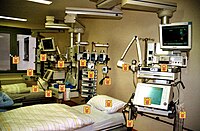
Photo from wikipedia
Background: Post-operative infections have many negative consequences for patients' health and the healthcare system. Among other things, they increase the recovery time and the risk of re-admission. Also, infection results… Click to show full abstract
Background: Post-operative infections have many negative consequences for patients' health and the healthcare system. Among other things, they increase the recovery time and the risk of re-admission. Also, infection results in penalties for hospitals and decreases the quality performance measures. Surgeons can take preventive actions if they can identify high-risk patients. The purpose of this study was to develop a model to help predict those patients at risk for post-operative infection. Methods: A retrospective analysis was conducted on patients with colorectal post-operative infections. Univariable analysis was used to identify the features associated with post-operative infection. Then, a support vector classification-based method was employed to select the right features and build prediction models. Decision tree, support vector machine (SVM), logistic regression, naïve Bayes, neural network, and random forest algorithms were implemented and compared to determine the performance algorithm that best predicted high-risk patients. Results: From 2016 to the first quarter of 2017, 208 patients who underwent colorectal resection were analyzed. The factors with a statistically significant association (p < 0.05) with post-operative infections were elective surgery, origin status, steroid or immunosuppressant use, >10% loss of body weight in the prior six months, serum creatinine concentration, length of stay, unplanned return to the operating room, administration of steroids or immunosuppressants for inflammatory bowel disease, use of a mechanical bowel preparation, various Current Procedural Terminology (CPT) codes, and discharge destination. However, accurate prediction models can be developed with seven factors: age, serum sodium concentration, blood urea nitrogen, hematocrit, platelet count, surgical procedure time, and length of stay. Logistic regression and SVM were stable models for predicting infections. Conclusion: The models developed using the pre-operative features along with the full list of features helped us interpret the results and determine the significant factors contributing to infections. These factors present opportunities for proper interventions to mitigate infection risks and their consequences.
Journal Title: Surgical infections
Year Published: 2020
Link to full text (if available)
Share on Social Media: Sign Up to like & get
recommendations!